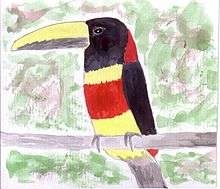Red-necked aracari
The red-necked aracari, or red-necked araçari (Pteroglossus bitorquatus), is a species of bird in the family Ramphastidae, the toucans, toucanets, aracaris, etc.
| Red-necked aracari | |
|---|---|
 | |
| Scientific classification | |
| Kingdom: | Animalia |
| Phylum: | Chordata |
| Class: | Aves |
| Order: | Piciformes |
| Family: | Ramphastidae |
| Genus: | Pteroglossus |
| Species: | P. bitorquatus |
| Binomial name | |
| Pteroglossus bitorquatus Vigors, 1826 | |
| Subspecies | |
|
See text | |
It is found in Bolivia and Brazil. Its natural habitats are subtropical or tropical moist lowland forests and heavily degraded former forest.
Taxonomy and systematics
Alternate names for the red-necked aracari include the double-collared aracari.
Subspecies
Three subspecies are recognized:[2]
- Western red-necked aracari (P. b. sturmii) - Natterer, 1843: Originally described as a separate species. Found in central Brazil to eastern Bolivia
- P. b. reichenowi - Snethlage, E, 1907: Originally described as a separate species. Found in north-central Brazil
- Brazilian red-necked aracari (P. b. bitorquatus) - Vigors, 1826: Found in north-eastern Brazil
Description
It is 38–45 cm (15–18 in) long and weighs 112-171 (4-6 oz.)[3] Both sexes are basically alike but the female has little to no black at the rear of the throat; crown more brown, less black or none; yellow band on breast narrower; bill shorter (Short/Horne). Immature birds are browner overall and lack vivid coloration. This species has a relatively long tail.
Habitat
The red-necked aracari is found in the southeast Amazon Basin and eastwards to the Atlantic coast on Marajó Island and the state of Maranhão, Brazil. It ranges only south of the Amazon River on the north, and southeastwards of the Madeira River in the west.
References
- BirdLife International (2012). "Pteroglossus bitorquatus". IUCN Red List of Threatened Species. 2012. Retrieved 26 November 2013.CS1 maint: ref=harv (link)
- "IOC World Bird List 6.4". IOC World Bird List Datasets. doi:10.14344/ioc.ml.6.4.
- "Archived copy". Archived from the original on 2007-08-19. Retrieved 2007-08-18.CS1 maint: archived copy as title (link)
External links
- Red-necked Aracari photo gallery VIREO Photo-High Res
- Photo-Medium Res; Article nashvillezoo–"Ramphastidae"–South America species, with Range Maps
